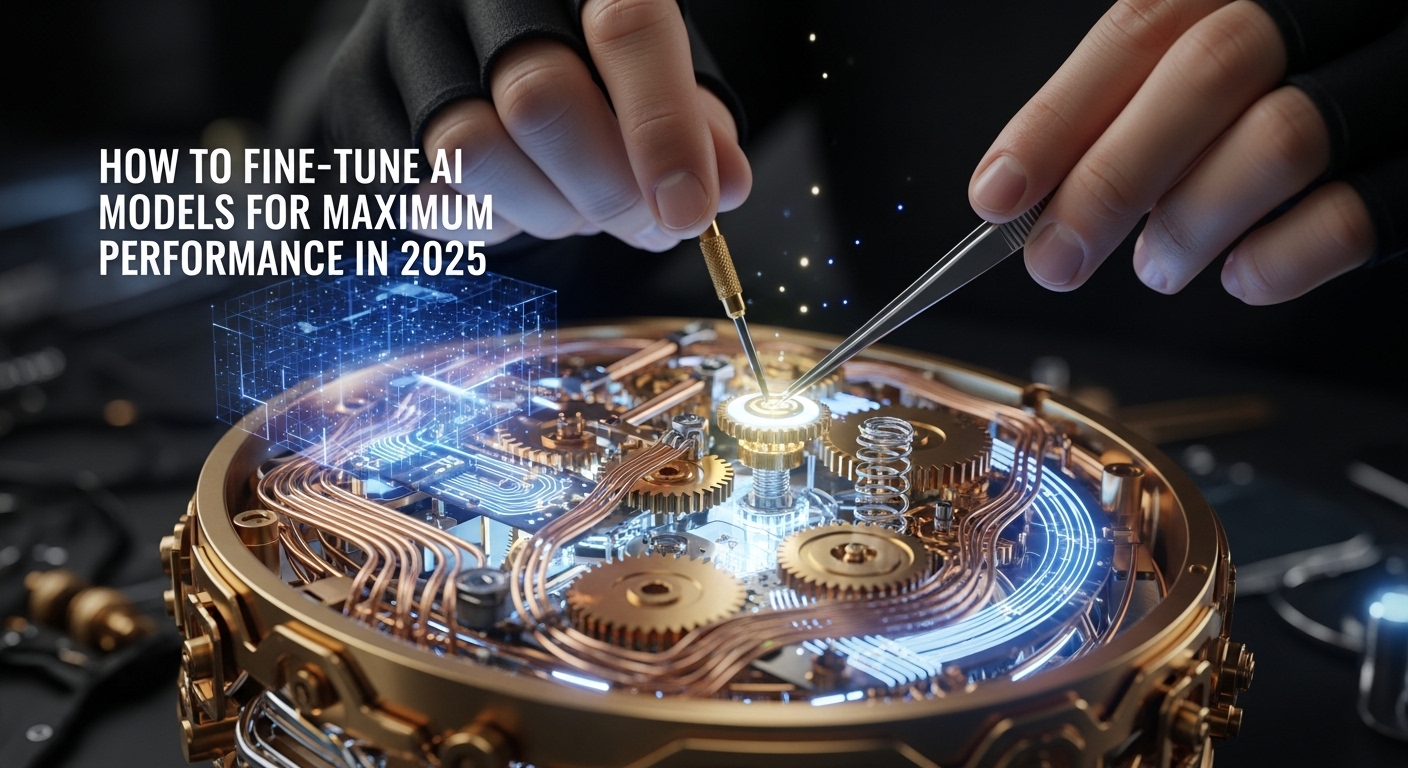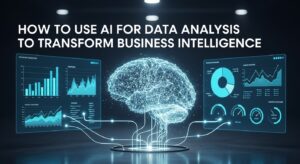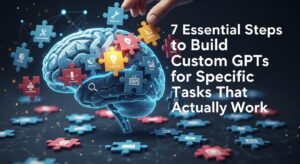Learning how to fine-tune AI models has become one of the most powerful skills in today’s AI-driven landscape. But what exactly does this process entail, and why should you invest time in mastering it?
Fine-tuning represents the bridge between generic AI capabilities and specialized solutions tailored to your unique requirements. Instead of building models from scratch—a process that demands massive computational resources and extensive datasets—fine-tuning allows you to adapt pre-trained models to excel at your specific tasks.
Think of it this way: Would you rather spend months teaching someone a completely new language, or take someone who already speaks it fluently and help them master your industry’s specialized vocabulary? Fine-tuning follows the latter approach, leveraging existing AI knowledge while customizing it for your particular domain.
What Does It Mean to Fine-Tune AI Models?
When you fine-tune AI models, you’re essentially taking a pre-trained model—one that has already learned general patterns from vast datasets—and teaching it to specialize in your specific domain or task. This process involves continuing the training process with your own carefully curated dataset.
The beauty of fine-tuning lies in its efficiency. Rather than starting from zero, you begin with a model that already understands language, recognizes patterns, or processes images. Your job becomes refining these existing capabilities to match your exact needs.
Key Components of AI Model Fine-Tuning
Fine-tuning involves several critical elements that work together to create your customized solution:
- Base Model Selection: Choosing the right pre-trained model serves as your foundation. Popular options include GPT models for language tasks, BERT for understanding context, or ResNet for image recognition.
- Dataset Preparation: Your training data must accurately represent the tasks you want your model to perform. Quality trumps quantity—a smaller, well-curated dataset often produces better results than a large, noisy one.
- Training Configuration: Setting appropriate learning rates, batch sizes, and training epochs ensures your model learns effectively without overfitting to your specific examples.
How to Fine-Tune AI Models: A Step-by-Step Framework
Step 1: Define Your Objectives and Success Metrics
Before diving into technical implementation, clearly articulate what you want your fine-tuned model to accomplish. Are you building a customer service chatbot that needs to understand your product catalog? Creating a content classifier for your specific industry? Developing a recommendation system for your user base?
Establishing measurable success criteria early prevents scope creep and guides your entire fine-tuning process. Consider metrics like accuracy, response time, user satisfaction scores, or business impact measurements.
Step 2: Select Your Base Model Architecture
The foundation you choose significantly impacts your final results. Here’s how different base models excel in various scenarios:
Model Type | Best For | Examples |
Large Language Models | Text generation, conversation, analysis | GPT-4, Claude, Llama |
Encoder Models | Classification, sentiment analysis | BERT, RoBERTa |
Computer Vision Models | Image recognition, object detection | ResNet, YOLO, ViT |
Multimodal Models | Combined text and image tasks | CLIP, DALL-E |
Step 3: Prepare Your Training Dataset
Dataset quality determines fine-tuning success more than any other factor. Your data should be:
- Representative: Include examples that mirror real-world scenarios your model will encounter
- Balanced: Avoid overrepresenting certain categories or responses
- Clean: Remove duplicates, correct errors, and ensure consistent formatting
- Sufficient: While you don’t need millions of examples, you need enough to establish clear patterns
Consider starting with 500-1000 high-quality examples for most fine-tuning tasks, then expanding based on initial results.
Step 4: Configure Your Fine-Tuning Parameters
When you fine-tune AI models, parameter selection can make or break your results. Key settings include:
- Learning Rate: Start conservatively (1e-5 to 1e-4) to avoid catastrophic forgetting of the base model’s knowledge
- Batch Size: Balance between training stability and computational efficiency
- Number of Epochs: Monitor validation metrics to prevent overfitting
- Regularization: Apply techniques like dropout or weight decay to maintain generalization
Step 5: Execute Training and Monitor Progress
Modern fine-tuning platforms like Hugging Face, OpenAI’s Fine-tuning API, or Google’s Vertex AI provide user-friendly interfaces for this process.
Throughout training, track key metrics:
- Training loss (should decrease steadily)
- Validation loss (should decrease without diverging from training loss)
- Task-specific metrics (accuracy, F1 score, BLEU score, etc.)
- Resource utilization and training time
Advanced Techniques to Fine-Tune AI Models More Effectively
Parameter-Efficient Fine-Tuning (PEFT)
Rather than updating all model parameters, PEFT methods like LoRA (Low-Rank Adaptation) or adapters modify only small portions of the model. This approach:
- Reduces computational requirements by up to 90%
- Prevents catastrophic forgetting more effectively
- Enables faster experimentation with different configurations
- Allows multiple task-specific adaptations of the same base model
Few-Shot Learning Integration
Combining fine-tuning with few-shot learning techniques can dramatically improve performance on tasks with limited training data. This hybrid approach leverages both the model’s pre-trained knowledge and your specific examples to achieve better generalization.
Multi-Task Fine-Tuning
Instead of optimizing for a single task, multi-task fine-tuning trains your model on several related objectives simultaneously. This technique often improves overall performance and creates more robust, versatile models.
Common Challenges When You Fine-Tune AI Models
Overfitting Prevention
Overfitting occurs when your model memorizes training examples rather than learning generalizable patterns. Combat this by:
- Using validation sets to monitor performance on unseen data
- Implementing early stopping when validation metrics plateau
- Applying regularization techniques
- Ensuring diverse, representative training data
Catastrophic Forgetting
Fine-tuning can sometimes cause models to “forget” their original capabilities while learning new tasks. Mitigation strategies include:
- Conservative learning rates
- Regularization techniques that preserve important parameters
- Gradual unfreezing of model layers
- Multi-task learning approaches
Resource Management
Fine-tuning can be computationally intensive. Optimize your approach by:
- Starting with smaller model variants for initial experiments
- Using gradient checkpointing to reduce memory usage
- Leveraging cloud computing resources for scalable training
- Implementing efficient data loading and preprocessing pipelines
Tools and Platforms for Fine-Tuning Success
Cloud-Based Solutions
- OpenAI Fine-Tuning API: Ideal for GPT model customization with minimal technical overhead
- Google Vertex AI: Comprehensive platform supporting various model types and frameworks
- AWS SageMaker: Enterprise-grade solution with extensive MLOps capabilities
- Microsoft Azure Machine Learning: Integrated environment with strong enterprise features
Open-Source Frameworks
- Hugging Face Transformers: Most popular library for transformer model fine-tuning
- PyTorch Lightning: Streamlines training loops and experiment management
- TensorFlow/Keras: Google’s framework with extensive fine-tuning capabilities
- Ludwig: Declarative deep learning framework requiring minimal coding
Measuring Success: Evaluation Metrics for Fine-Tuned Models
Task-Specific Metrics
Different applications require different evaluation approaches:
- Language Models: Perplexity, BLEU score, ROUGE score, human evaluation
- Classification Models: Accuracy, precision, recall, F1 score, AUC-ROC
- Generation Models: Coherence, relevance, factual accuracy, style consistency
Business Impact Assessment
Beyond technical metrics, evaluate how your fine-tuned model affects:
- User engagement and satisfaction
- Operational efficiency gains
- Cost reduction or revenue impact
- Time savings for your team or customers
Best Practices for Long-Term Success
Continuous Improvement Cycles
Plan for iterative refinement of your fine-tuned models:
- Regular Performance Monitoring: Track metrics over time to identify degradation
- Data Collection: Continuously gather new examples to improve your training dataset
- A/B Testing: Compare different model versions to validate improvements
- Feedback Integration: Incorporate user feedback into your training process
Version Control and Reproducibility
Maintain detailed records of:
- Training datasets and their sources
- Model configurations and hyperparameters
- Training logs and performance metrics
- Environmental conditions and dependencies
This documentation enables you to reproduce successful experiments and troubleshoot issues effectively.
Real-World Applications and Success Stories
- Customer Service Automation: Companies like Zendesk have successfully used fine-tuned models to create intelligent ticket routing systems that understand context-specific customer inquiries, resulting in 40% faster resolution times.
- Content Creation and Marketing: Marketing teams leverage fine-tuned language models to generate brand-consistent content across multiple channels, maintaining voice and style while scaling content production by 300%.
- Healthcare and Scientific Research: Research institutions fine-tune models on medical literature and clinical data to assist with diagnosis, treatment recommendations, and drug discovery processes, accelerating research timelines significantly.
Future Trends in AI Model Fine-Tuning
- Automated Fine-Tuning (AutoML): Emerging platforms are making fine-tuning accessible to non-technical users through automated parameter selection, dataset optimization, and performance tuning.
- Edge Computing Integration: As models become more efficient, fine-tuning for edge deployment is growing, enabling personalized AI experiences without cloud dependencies.
- Federated Fine-Tuning: Privacy-preserving techniques allow organizations to collaboratively fine-tune models without sharing sensitive data, opening new possibilities for industry-wide improvements.
Getting Started: Your Next Steps
Ready to begin your journey to fine-tune AI models for your specific needs? Here’s your action plan:
- Identify Your Use Case: Start with a specific, well-defined problem where AI can provide clear value
- Gather Initial Data: Collect 200-500 high-quality examples representing your target task
- Choose Your Platform: Select a fine-tuning platform based on your technical expertise and requirements
- Run Your First Experiment: Start with a simple configuration and iterate based on results
- Measure and Improve: Establish feedback loops for continuous model enhancement
Remember, successful fine-tuning is more art than science. Each domain presents unique challenges and opportunities. The key lies in understanding your data, choosing appropriate techniques, and maintaining a systematic approach to experimentation and improvement.
The investment in learning to fine-tune AI models pays dividends through improved accuracy, reduced costs, and capabilities perfectly aligned with your unique requirements. As AI continues evolving, those who master fine-tuning will maintain significant competitive advantages in their respective fields.











